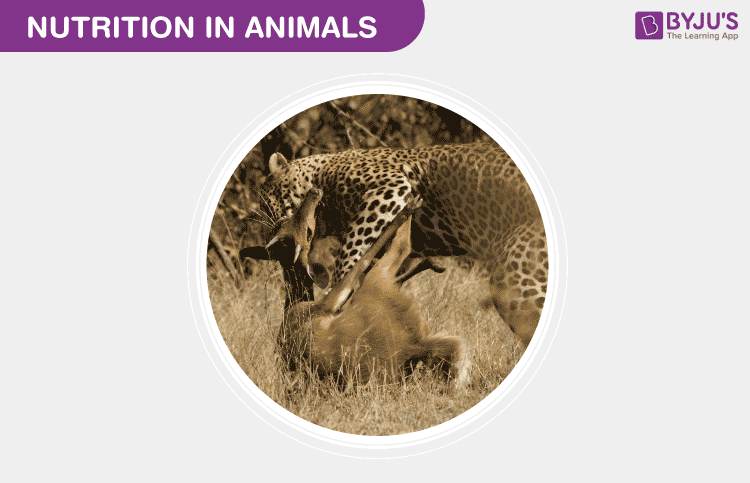Table of Contents
- Introduction
- Nutrition in Animals
- Types of Nutrition in Animals
- Process of Nutrition in Animals
- Nutrition in Simple Animals
Introduction
Nutrition in animals is as important as it is for plants. Plants prepare their own food by the process of photosynthesis but animals cannot prepare their own food, hence they need to depend on plants or other animals for their food.
Animals derive their nutrition either by eating plants directly (herbivores), or indirectly by eating animals which have consumed plants (carnivores). Some animals feed on both plants and animals; these animals are termed omnivores. All organisms require food for their survival and growth.
Food has different components, called nutrients, like carbohydrates, fats, minerals, proteins, and vitamins, which are required for the maintenance of the body. These components are complex and cannot be used directly, so they are broken down into simpler components by the process of digestion.

Also Read: Nutrition in Living Organisms
Nutrition in Animals
Nutrition in animals depends upon the feeding habits of the animals. The process of taking in food is called ingestion. The method of ingestion is different in different animals. For example-Bees and hummingbirds suck nectar from plants, a python swallows its prey and cattle feed on grass.
Different feeding habits of animals are the result of evolution. Among the terrestrial animals, the earliest forms were large amphibians that ate fish. While amphibians like frogs fed on small fish and insects, the reptiles began feeding on other animals and plants.
The specialization of organisms towards specific food sources and of course specific ways of eating is one of the major causes of the evolution of form and function. For example, the differences in the parts of the mouth and shape of the teeth in whales, mosquitos, tigers and sharks or distinct forms of beaks in birds, such as in hawks, woodpeckers, pelicans, hummingbirds, and parrots are the results of adaptation to different types of eating by these animals.
Animals can be divided into the following groups depending upon their food habits:
Herbivores: Herbivores are animals that depend upon plants and fruits for their nutrition. Cows, goats, sheep, buffaloes, etc. are herbivores.
Carnivores: Carnivores are animals that depend upon other animals for food. Lion, tigers, wolfs are some examples of carnivores.
Omnivores: These include organisms that eat both plants and animals. Humans, bears, dogs, crows are omnivores.
Also Read: Nutrition in Plants
Types of Nutrition in Animals
The different types of nutrition in animals include:
- Filter Feeding: obtaining nutrients from particles suspended in water. Commonly used by fish.
- Deposit feeding: obtaining nutrients from particles suspended in the soil. Earthworms use this mode of ingestion.
- Fluid feeding: obtaining nutrients by consuming other organisms’ fluids. Honey bees, and mosquitos exhibit this mode of food intake.
- Bulk feeding: obtaining nutrients by eating the whole of an organism. Example: Python.
- Ram feeding and suction feeding: ingesting prey via the surrounding fluids. This mode of ingestion is usually exhibited by aquatic predators such as bony fish.
Refer more: Nutrients
Process of Nutrition in Animals
The process of nutrition in animals involves the following steps:
Ingestion
Ingestion is the process of taking in food.
Digestion
In this process, the larger food particles are broken down into smaller, water-soluble particles. There are physical or chemical processes for digesting food.
Absorption
The digested food is absorbed into the bloodstream through the intestinal wall.
Assimilation
The absorbed food is used for energy, growth and repair of the cells of the body.
Egestion
The undigested food is removed from the body in the form of faeces. This process is known as egestion.
Nutrition in Simple Animals
Amoeba
- Amoeba ingests its food with the help of pseudopodia.
- The food is engulfed by forming a vacuole and is digested with the help of digestive enzymes.
- The digested food is absorbed directly into the cytoplasm by the process of diffusion.
- Energy is obtained from the absorbed food that helps in its growth.
- The undigested food is egested out of the body of amoeba by rupturing the cell wall.
Also Read: Nutrition in Amoeba
To know more about nutrition in animals, its types and the process of nutrition in animals and other related topics, visit us at BYJU’S Biology.
Frequently Asked Questions
Why is nutrition important for animals?
Nutrition helps in the proper growth and maintenance of the cells. It provides energy to carry out different life processes.
What are the two important modes of nutrition?
The two important modes of nutrition include:
- Autotrophic nutrition: In this type of nutrition, the plants and other photosynthetic organisms prepare their own food with the help of sunlight, water and carbon dioxide.
- Heterotrophic nutrition: The animals cannot prepare their own food. Therefore, they have to rely on other animals for nutrition. This is known as heterotrophic nutrition.


byjus is a good thing for study
It’s nice
Byju’s is the best way to learn at home 🏡
I love it 💞
Very much helpful !!
Thank you so much
Really nice thanks to BYJU’S